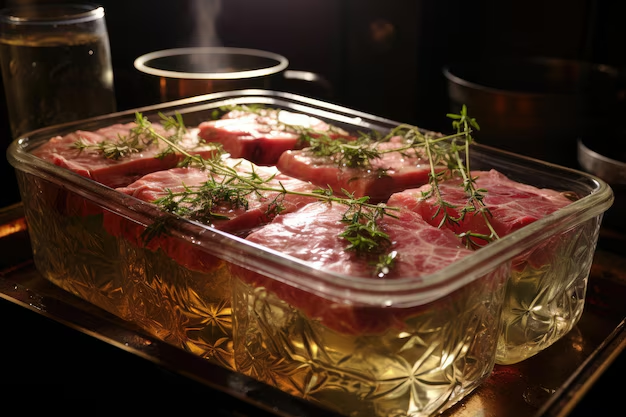How Long Does Beef Tallow Last in the Fridge? A Comprehensive Guide to Storage & Shelf Life
Imagine opening your refrigerator, reaching in for that versatile kitchen staple—beef tallow. Whether you're a seasoned chef or a home cook experimenting with traditional fats, knowing how long your beef tallow lasts is crucial for maintaining flavor and food safety. This article delves into the intricate details of storing beef tallow in the refrigerator, ensuring it stays fresh and usable.
🥩 Understanding Beef Tallow
Beef tallow is rendered beef fat, a time-honored ingredient used for cooking, baking, and even making skincare products. Renowned for its rich flavor and high smoking point, it is a favorite among those who appreciate traditional cooking fats.
What Makes Beef Tallow Special?
- High Smoke Point: Ideal for frying and searing; it doesn’t break down at high temperatures.
- Rich Flavor: Adds depth and umami to dishes, making it a preferred fat for many culinary uses.
- Shelf Stability: Unlike some animal fats, tallow can be quite shelf-stable when stored properly.
🕒 How Long Does Beef Tallow Last in the Refrigerator?
The longevity of beef tallow in the fridge depends on several factors, from how it's stored to its starting freshness.
General Shelf Life
Beef tallow typically lasts 6 months to a year in the refrigerator. This timeframe can vary based on storage conditions and initial preparation quality.
Factors Influencing Shelf Life
- Temperature Stability: Consistent refrigeration at optimal temperatures helps extend shelf life.
- Container Type: Airtight containers prevent contamination and oxidation.
- Purity and Preparation: Proper rendering and filtering ensure fewer impurities, prolonging freshness.
🥶 Best Practices for Storing Beef Tallow
Proper storage can make a significant difference in the shelf life of beef tallow. Here's how you can maximize its freshness:
Choosing the Right Container
- Airtight Jars: Glass jars with tight-fitting lids are ideal for keeping air and moisture out.
- Vacuum-Sealed Bags: Remove air to prevent oxidation and extend shelf life.
- Avoid Plastic Containers: Some plastics can leach chemicals or absorb flavors.
Refrigeration Tips
- Consistent Temperature: Store tallow in the coldest part of the refrigerator to maintain a stable temperature.
- Label and Date: Always label your containers with the date of storage for easy monitoring.
🧐 Spotting Spoilage in Beef Tallow
Despite careful storage, beef tallow can still spoil. Knowing the signs of spoilage can prevent foodborne illnesses and kitchen mishaps.
Signs That Your Tallow Has Gone Bad
- Rancid Odor: A sour or unpleasant smell indicates spoilage.
- Discoloration: Darkening or mold suggests contamination.
- Off-Taste: A sour or bitter flavor is a clear sign that it shouldn’t be consumed.
📊 Quick Tips for Maintaining Freshness
Here’s a handy summary of practical tips to ensure your beef tallow remains fresh and safe:
- 🥄 Use Clean Utensils: Always use clean, dry utensils when scooping tallow to avoid introducing bacteria.
- 📅 Rotate Stock: Use the oldest batch first to minimize waste.
- ❄️ Consider Freezing: For long-term storage beyond 6 months, freezing is an excellent option.
🌡️ Beyond the Refrigerator: Alternative Storage Options
While refrigeration is common, there are other methods to store beef tallow effectively:
Freezing Beef Tallow
Freezing extends the shelf life of tallow significantly, often up to two years. Frozen tallow retains its nutritional qualities and flavor.
- Proper Packaging: Use vacuum-sealed bags or freezer-safe containers to prevent freezer burn.
- Portion Sizes: Freeze in usable portions to avoid thawing more than necessary.
Room Temperature Storage
Under certain conditions, beef tallow can be stored at room temperature, especially if it’s been filtered for impurities and stored in airtight conditions. This method is less common due to variances in room temperature stability.
🧑🍳 Practical Uses: Making the Most of Beef Tallow
Understanding beef tallow’s shelf life can help you plan its usage efficiently in the kitchen.
Culinary Applications
- Frying and Sautéing: Its high smoke point makes it ideal for crispy fries and seared meats.
- Baking: Substitute for butter or shortening in pie crusts and pastries for a richer flavor.
Non-Culinary Uses
Besides cooking, beef tallow serves other purposes too:
- Skincare: Used as a base in homemade lotions and balms.
- Soap Making: Traditional tallow soap is prized for its gentle, moisturizing properties.
🤔 Frequently Asked Questions
Is cloudiness in beef tallow normal?
Yes, beef tallow can appear cloudy when cooled and solidified. This is a natural state and does not affect its quality or taste.
Can you reuse beef tallow from cooking?
Reused tallow should be strained of any impurities before storing. Note that each subsequent use might slightly reduce its quality.
How to revive tallow that’s starting to spoil?
If spoilage signs appear, it’s best not to use the tallow. Attempting to fix it may not eliminate spoilage and could be unsafe.
🎯 Key Takeaways
- 🕒 Longevity: Beef tallow lasts 6 months to a year in the refrigerator when stored properly.
- 🥶 Storage: Use airtight containers and consistent refrigeration to prolong shelf life.
- 👃 Spoilage Signs: Rancid odor, discoloration, and strange tastes indicate spoilage.
- ❄️ Features: Consider freezing for long-term storage and keep an eye on physical changes.
Incorporating these practices will not only help keep your beef tallow fresh but also ensure its quality and safety in all your delicious endeavors. By understanding the nuances of beef tallow storage, you are empowered to make the most of this wonderful culinary fat, enjoying its benefits for longer periods with minimal waste.
